In a groundbreaking collaboration between the European Space Agency (ESA) and NASA, a solar observatory equipped with advanced instruments has been diligently scanning the skies, capturing celestial phenomena for years.
Milestone: Identifying the 5,000th Comet
The recent revelation of identifying the 5,000th comet underscores the remarkable success of the mission and highlights the wealth of data gathered to unravel the mysteries of our cosmic neighborhood.
Understanding Comets
- Nature of Comets: Comets, often dubbed as “dirty snowballs” or “icy dirtballs,” are remnants from the formation of the solar system.
- Importance: They hold vital clues about the early stages of planetary evolution.
- Composition: Comets are icy bodies that orbit the Sun, occasionally venturing close enough to Earth for observation.
Dr. Amanda Hayes’ Statement
Dr. Amanda Hayes, lead astronomer on the project, expressed her excitement about reaching this milestone and emphasized the unique characteristics of each comet, providing insights into the history and dynamics of our solar system.
Implications of Cometary Research
- Water Origins: Understanding comets helps in understanding the origins of water on Earth.
- Impact Assessment: Evaluation of potential threats from cometary impacts.
- Solar System Models: By tracking comets, scientists can refine models of solar system formation and improve trajectory prediction.
Importance of International Cooperation
The collaborative efforts between ESA and NASA highlight the importance of international cooperation in space exploration. Sharing of resources, expertise, and data accelerates scientific progress and fosters a deeper understanding of the cosmos.
Future Prospects
As the solar observatory continues its vigilant watch over the heavens, astronomers anticipate further discoveries that will expand our knowledge of cometary behavior and shed light on the intricate workings of our solar system.
Multiple Choice Questions (MCQ):
- What recent achievement was highlighted in the collaboration between ESA and NASA?
- A) Identifying the 10,000th asteroid
- B) Identifying the 5,000th comet
- C) Discovering a new exoplanet
- D) Capturing images of a distant galaxy
- What are comets often referred to as?
- A) Icy giants
- B) Dirty snowballs or icy dirtballs
- C) Stellar remnants
- D) Planetary fossils
- What insights do comets provide about the solar system’s early stages?
- A) Insights into planetary evolution
- B) Insights into star formation
- C) Insights into black hole dynamics
- D) Insights into galaxy clustering
- What is Dr. Amanda Hayes’ role in the project?
- A) Lead engineer
- B) Lead astronomer
- C) Project manager
- D) Lead physicist
- What is one of the implications of cometary research mentioned in the text?
- A) Understanding the origins of comets
- B) Evaluating potential threats from asteroid impacts
- C) Assessing the formation of moons
- D) Analyzing the atmospheres of gas giants
